Tokyo Tea Ceremony & Fun Wagashi Making Experience with a Geisha
“The tea ceremony… celebrates the aesthetic beauty in the mundane, the superiority of the spirit over matter, and tranquility.” ~ J. Bacarr. Did you know that geisha aren’t only found in Kyoto, and it’s possible to add a Tokyo...

“The tea ceremony… celebrates the aesthetic beauty in the mundane, the superiority of the spirit over matter, and tranquility.” ~ J. Bacarr.
Did you know that geisha aren’t only found in Kyoto, and it’s possible to add a Tokyo tea ceremony to your Japan itinerary?
If you’ve read my review about eating my way through old town Tokyo in Yanaka, you may be eager to hear about the special tea ceremony I experienced afterwards. Being taught by a geisha how to make our own wagashi (traditional Japanese sweets) to eat during the ceremony was just exceptional!
Let me begin by saying that I completed a traditional tea ceremony in Kyoto on one of my previous visits to Japan. This experience can be quite formal and tradition requires guests to be seated on their knees for the duration of the ceremony (it’s not always easy).
With this knowledge I was fairly certain about what to expect, however my tea ceremony in Tokyo was different, and in a pleasant way. A little on the informal side, this approach is to help guests feel relaxed and more comfortable than it may be elsewhere.
If after your Yanaka foodie tour you want to have an unforgettable tea ceremony in Tokyo with antique bowls, AND learn how to make your own wagashi, read on for more!
This guide to a Tokyo tea ceremony will cover:
Who are Arigato Japan Tours? What to expect at a Tokyo tea ceremony Making wagashi: One of the lesser-known things to do in Tokyo The first wagashi The second wagashi Decorating our dishes before the tea ceremony experience Enjoying the tea ceremony in Tokyo How to book your own Tokyo tea ceremonyI experienced this Tokyo tea ceremony & wagashi making class as a press invite. As always, all thoughts and opinions are my own. This post contains affiliate links, at no extra cost to you. I may earn a small commission if you click through and make a purchase.
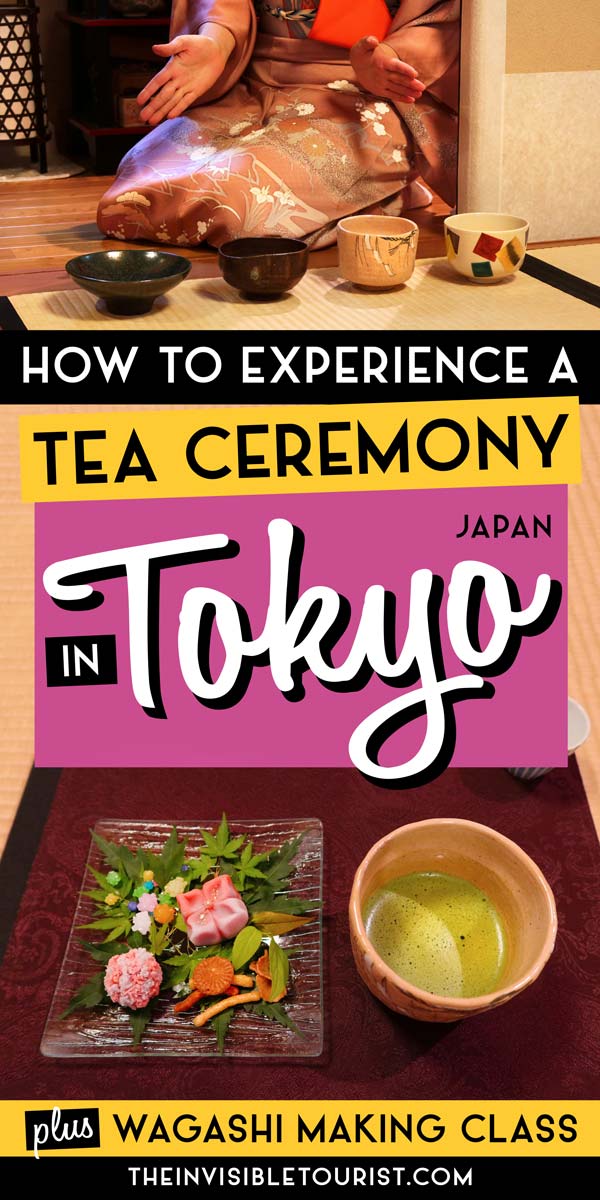 Pin me to Pinterest for reference later! 📌
Pin me to Pinterest for reference later! 📌Who are Arigato Japan Tours?
I was invited to undertake this unique experience by Arigato Japan Tours. Specialising in small group experiences with a focus on culturally significant foods and drinks throughout Japan, Arigato Japan Tours help connect visitors with local businesses in a meaningful way.
I’m very passionate about this win-win situation for tourists and locals, as it’s an essential part of blending in in Japan. It’s also one of the reasons why I wrote a book on this subject and I created my Japan travel blog to help you achieve this!
The best part is tours can be especially tailored to suit your dietary requirements, so just let them know at the time of booking.
What to expect at a Tokyo tea ceremony
Tea ceremonies are one of my favourite Japan cultural experiences – I adore the upholding of history and tradition combined with the attention to detail in every aspect of the tea room itself.
Our tea ceremony location was tucked away in the Yanaka neighbourhood with a lovely antique store on the ground floor. This family-run business has just celebrated 100 years in operation!
When being introduced to the lovely owners and their daughter, I was surprised that our group was able to leave our shoes on as we made our way up the stairs. Usually, we would need to leave them at the entrance.
Making wagashi: One of the lesser-known things to do in Tokyo
As mentioned in my guide to snacks from Japan, wagashi is a general term for sweets made in traditional Japanese style. When part of a tea ceremony, wagashi are usually themed with the current season to help celebrate it.
Today, the wagashi we were going to make by hand were mochi hydrangeas for the summer rainy season (a type of sweet, chewy rice cake with red bean paste centre).
Take it from me, being taught how to make these from a geisha was such a special moment. It gave me a HUGE new appreciation for the amount of effort that goes into bringing these edible little artworks to life!
The first wagashi
When seated at our tables, our mochi was ready to be moulded into shape alongside the simple wooden tools we were to use. My lovely guide Lauren sat this one out and shared her tips with plenty of encouragement along the way.
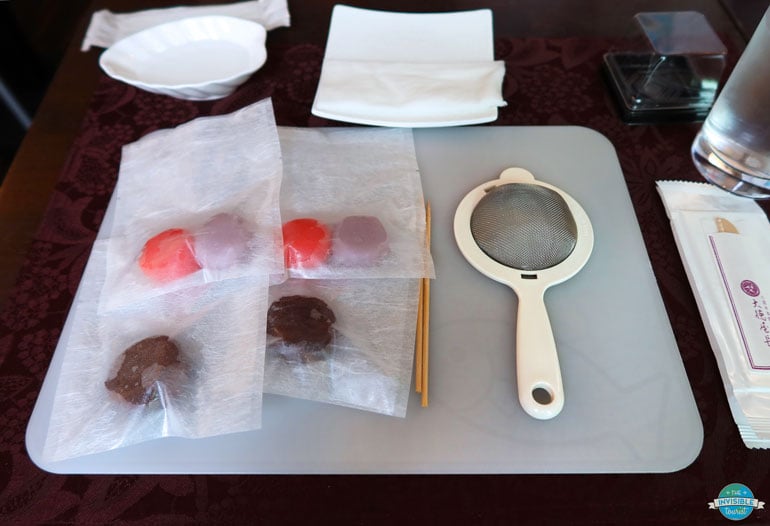
Our first wagashi was in the shape of a single hydrangea flower, its pink and purple colouring blended beautifully. The second was a lovely little ball of frilly hydrangea petals. Yes, I was about to make THESE… eeek!

Our sensei geisha (teacher) demonstrated each step. It was a very interesting process which I’ve simplified below, but you’ll learn all the details in the class itself:
We started by blending two coloured pieces of “dough” together. Forming the dough into a flat round shape before cupping it in our hands, we added the round ball of red bean paste into the centre, then enclosed it completely. From there, we used a flat wooden tool to score four lines into the dough. Then, we used our pinky fingers to indent the four petals and pinched the sides to create pointed edges. In the centre of our flower, we added a small ball to represent the pollen. Finally, we added gold leaf flakes as a finishing touch. The gold leaf was to represent sparkling raindrops on the petals.In between steps, there was a lot of sprinkling water on our hands so the dough didn’t stick to our fingers. Our sensei made everything look very easy!
The second wagashi
While this one looks WAY more complicated than the first, it was actually less time-consuming to put together! The shape of this wagashi also represented hydrangeas in bloom.
It does require a bit of a steady hand and patience, but if I can do it you’ll surely be able to as well.
Our sensei demonstrated how to push 3 separate pieces of coloured dough through a sieve/mesh strainer to form miniature flower puffs, before using small skewers like chopsticks to place them around a ball of red bean paste.
Once pushed through the sieve, the dough fibres were so delicate and it took some practice in making sure they were a good length for plucking. The trickiest part was placing the little fibres around the base of the red bean ball!
Decorating our dishes before the tea ceremony experience
After we’d finished making our wagashi, we were handed some loose Japanese maple leaves, konpeito and savoury snacks to decorate a dish. We’d bring this dish with us to the tea ceremony and eat the wagashi to sweeten our palate before drinking tea.
I mindfully arranged the leaves and snacks in a way I thought looked the most pleasing. Quite happy with the results, I think mine turned out quite pretty!

Enjoying the tea ceremony in Tokyo
As we walked into the tea room, Lauren pointed out that we didn’t need to sit on our knees in the traditional way. Seating in this Tokyo tea house was built beneath the ceremony floor, so guests can sit normally like they would at a table. To be honest, my thighs were delighted!
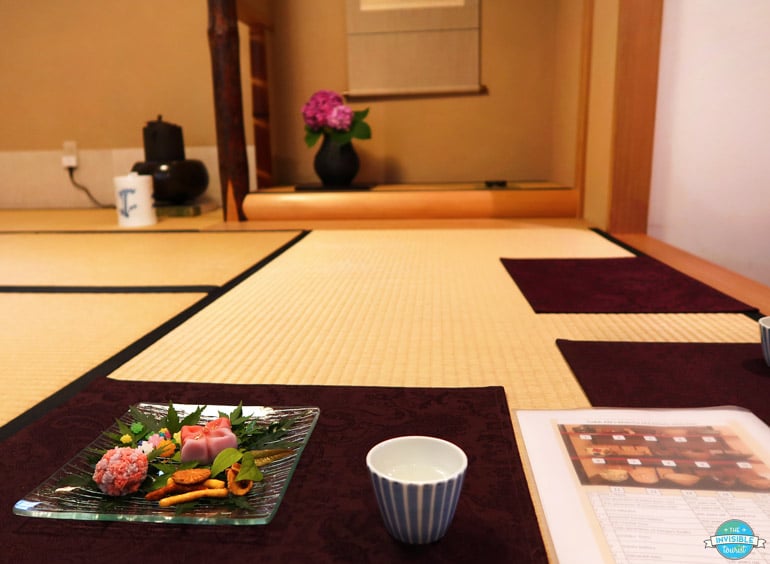
Our sensei geisha then presented us with a tea bowl “menu,” where we could select our own beautiful bowl to drink our tea. These were a host of antique bowls from various regions throughout Japan, some are as old as 250-300 years! Sensei removed her apron to reveal a beautiful kimono.
NOTE: To use the oldest bowls, you will need to remove any rings/jewellery from your hands. My rings were stuck on, so I selected a 40 year old bowl made in Kyoto instead. My bowl featured a hand-painted image about the purification ritual in Japanese culture for the second half of the year.
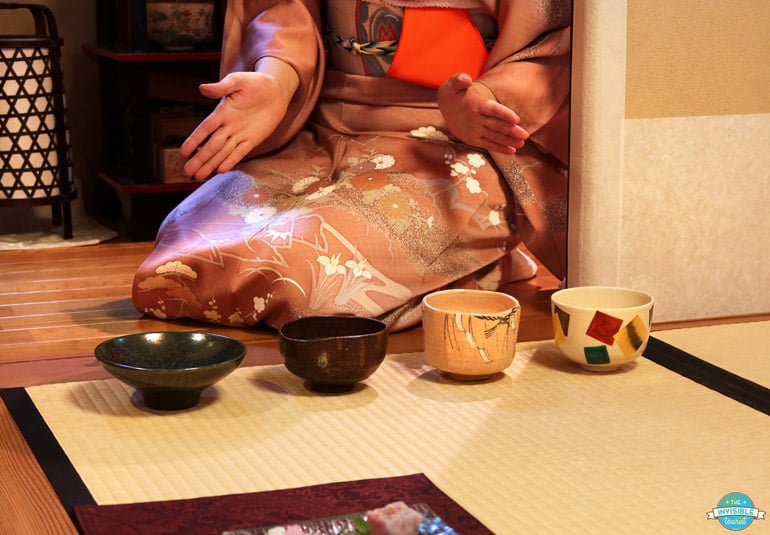
Our sensei proceeded to make us each green tea in our chosen bowls. Be sure to watch all her elegant hand gestures because they each have meaning!
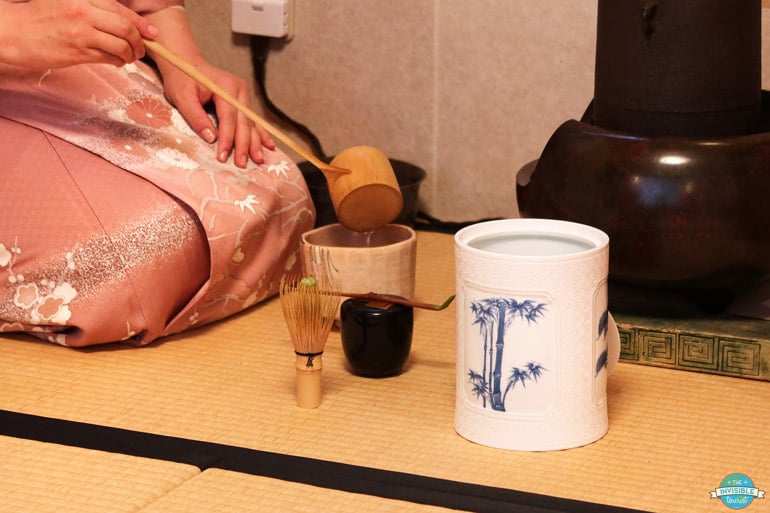
This was the time to cut our wagashi in half and enjoy it before drinking our tea. It was almost too pretty to eat.
TIP: In Japanese culture, it’s polite to slurp the final sip!
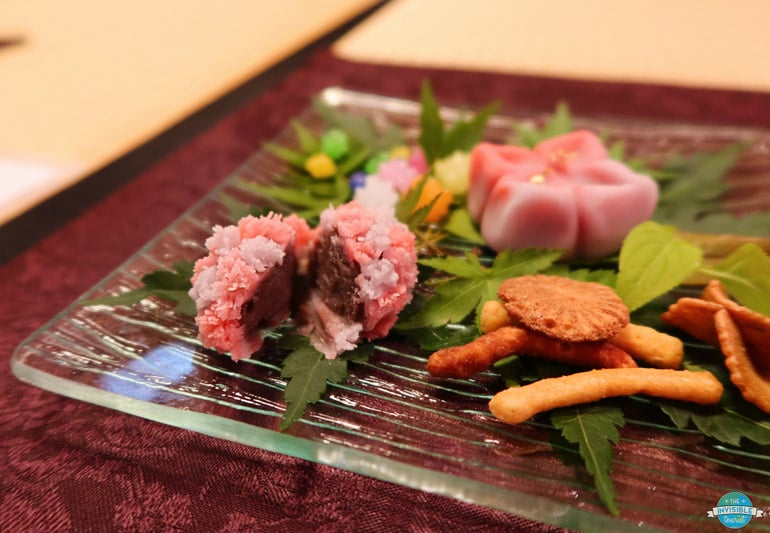
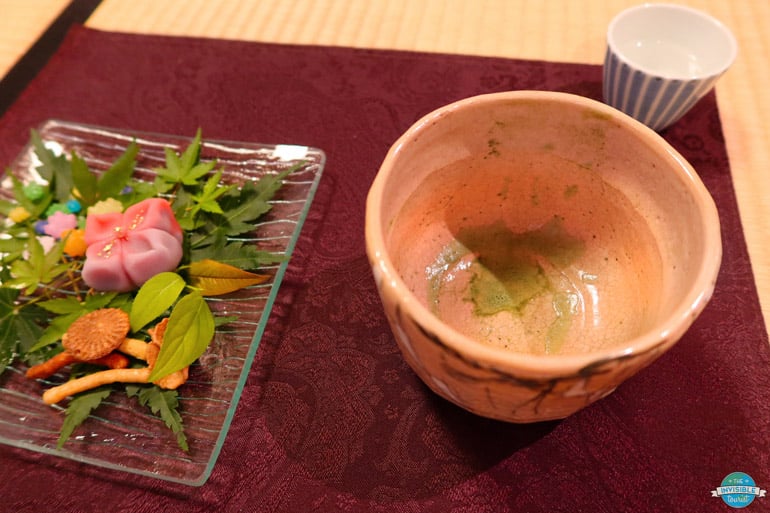
As we were enjoying our tea, Lauren described some Japanese tea ceremony history.
Many of the elements and thoughts behind creating a tea room, the meaning behind ichi-go ichi-e (read about his and more beautiful Japanese words), why the size of this room is significant, and even why there are many different kinds of wood used in the room’s structure.
I find this kind of thing super fascinating and it brings more meaning to the moment.
And now for the sweetest sentiment. After the ceremony, we each received a hand-drawn picture of our selected tea bowls from our geisha’s father. He drew them during the ceremony unbeknownst to us, and wrote down what our bowls represented.
I will always treasure this sketch as a reminder of our wonderful encounter.
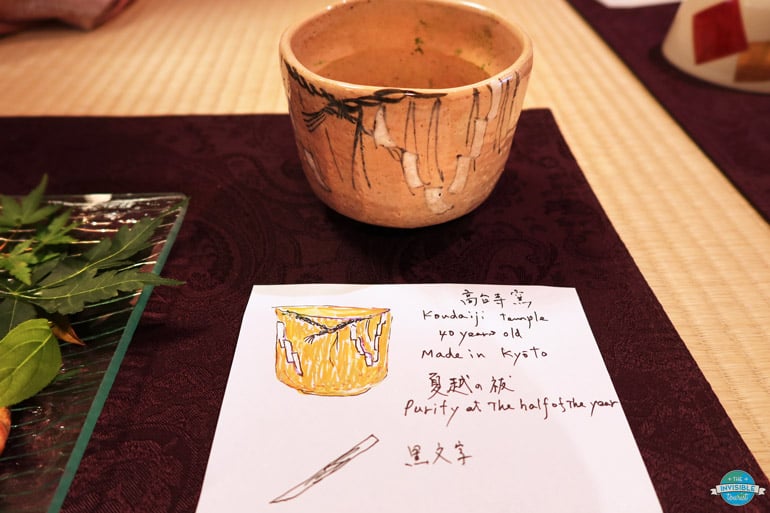
Final thoughts on this tea ceremony experience in Yanaka
Overall, this tea ceremony in Tokyo and wagashi making experience was relaxing, fun and very enjoyable.
I’d not done anything like wagashi-making before, and have to say it was one of the highlights of this Japan trip! Such a humbling experience to be taught this skill from a family business that’s 100 years old.
I believe every visitor should try and make the time for a matcha tea ceremony experience when planning a trip to Japan. You’ll learn to think with a different perspective on life, and how to view the world in a way you never realised before. Book your Old Town Tokyo & Tea Ceremony experience here.
Personally, I’m not exaggerating when I say Japanese tea ceremony experiences have been life-changing for me. Isn’t that truly special?
Sending a huge thanks again to Arigato Japan Tours for inviting me on this wonderful experience!
If you found this helpful please share it with your friends or come and join me on Facebook, Pinterest, Instagram and TikTok for more Japan inspiration!
Until next time,

Like it? Pin it! 📌
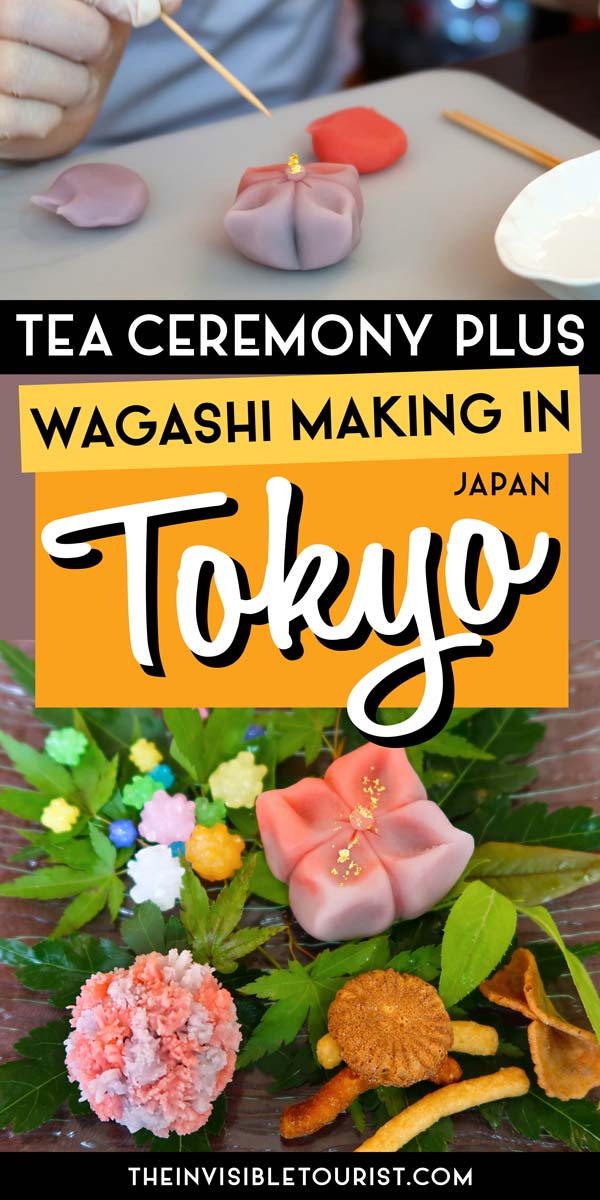
This guide to a tea ceremony in Tokyo contains some affiliate links, at no extra cost to you. I may earn a small commission if you decide to make a purchase and if you do, thanks for your support! This helps with the costs of running my blog so I can keep my content free for you. As always, I only recommend a product or service that I genuinely love and use myself!
Australian-based Alyse has travelled "The Invisible Tourist Way" for thirteen years and hopes to encourage fellow travellers to do so, too. Based on her travels to 250+ cities across 32 countries, through her blog she shares passionate advice about responsible travel, history and preserving local cultures for more enriching experiences. Her dreams? Always about the next destination and how to make the most of it by "blending in".

 Tekef
Tekef 
































